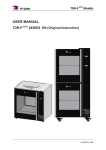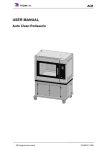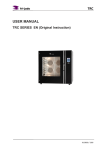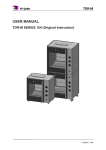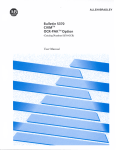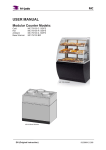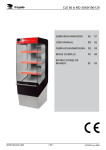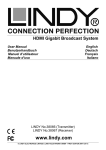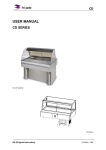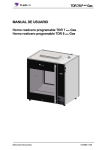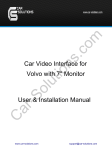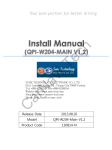Download USER MANUAL
Transcript
TDR 7/8 P eco Gas USER MANUAL TDR 7 Programmable eco Gas TDR 8 Programmable eco Gas EN (Original Instruction) 9123983 / 1309 TDR 7/8 P eco Gas KEEP THIS USER MANUAL FOR FUTURE USE © 2013 Fri-Jado BV, Etten-Leur, The Netherlands. We advise you to contact your supplier for the guarantee period and conditions. Further we refer to our General Terms and Conditions for Sales and Delivery that are available upon request. The manufacturer does not accept any liability for damage or injury caused by failing to adhere to these regulations or by not observing the usual caution or care in actions, operation, maintenance or repair activities, even if not explicitly described in this manual. As a result of constant commitment to improvement, it may happen that your unit deviates in detail from what is described in this manual. For this reason, the given instructions are only a guideline for the installation, use, maintenance and repair of the unit referred to in this manual. This manual has been composed with the utmost care. The manufacturer shall, however, not be held responsible for any mistakes in this manual nor for any consequences thereof. The user is allowed to copy this manual for own use. Further all rights are reserved and nothing in this manual may be reproduced and/or made public in any way. Modifications: In case of unauthorised modifications in or on the unit, every liability on the part of the manufacturer becomes null and void. EN 2 / 48 EN 3 / 48 TDR 7/8 P eco Gas TDR 7/8 P eco Gas CONTENTS 1. INTRODUCTION ............................................................................................................ 6 1.1. General ........................................................................................................................... 6 1.2. Identification of the unit ................................................................................................ 6 1.3. Pictograms and symbols ............................................................................................. 6 1.4. Safety instructions ........................................................................................................ 7 1.4.1. General ....................................................................................................................... 7 1.4.2. Moving ........................................................................................................................ 8 1.4.3. Outdoor use restrictions ........................................................................................... 8 1.5. Hygiene .......................................................................................................................... 9 1.6. Service and technical support ..................................................................................... 9 1.7. Storage ........................................................................................................................... 9 1.8. Disposal .......................................................................................................................... 9 2. DESCRIPTION OF THE UNIT .................................................................................... 10 2.1. Technical description ................................................................................................. 10 2.2. Intended use ................................................................................................................ 10 2.3. Accessories ................................................................................................................. 10 3. INSTALLATION AND FIRST USE ............................................................................. 11 3.1. Unpacking the unit ...................................................................................................... 11 3.2. Dismantling the pallet ................................................................................................. 12 3.3. Installation and positioning ........................................................................................ 12 3.4. First use ........................................................................................................................ 14 3.4.1. Metal odour .............................................................................................................. 15 4. OPERATION AND USE .............................................................................................. 16 4.1. Control Panel ............................................................................................................... 16 4.2. Switching-on the unit .................................................................................................. 17 4.3. Loading the rotisserie ................................................................................................. 17 4.3.1. Loading the rotisserie using meat forks .............................................................. 18 4.3.2. Loading the rotisserie using V-shape spits (accessory) ................................... 19 4.3.3. Loading the rotisserie using meat baskets (accessory) .................................... 20 4.3.4. Loading the rotisserie using chicken racks (accessory) ................................... 20 4.3.5. Loading the rotisserie using two different accessories. .................................... 21 4.4. Grilling time .................................................................................................................. 21 4.5. Taking out the products ............................................................................................. 22 4.5.1. Taking out the meat fork ........................................................................................ 22 4.5.2. Taking out the V-shape spit (accessory) ............................................................. 22 4.5.3. Taking out the chicken rack (accessory) ............................................................. 22 4.5.4. Taking out the meat basket (accessory) ............................................................. 22 4.6. EN Emptying grease drawer ............................................................................................ 23 4 / 48 4.7. 5. TDR 7/8 P eco Gas Switching-off the unit .................................................................................................. 23 OPERATION ................................................................................................................ 24 5.1. Operation of the rotisserie ......................................................................................... 24 5.2. Operation options ....................................................................................................... 27 5.2.1. To end a running program. .................................................................................... 27 5.2.2. Check the actual temperature ............................................................................... 27 5.2.3. Check the remaining time in a program .............................................................. 28 5.2.4. Show all actual program information ................................................................... 28 5.2.5. Eco function ............................................................................................................. 29 5.2.6. Cook correction ....................................................................................................... 29 5.2.7. Display information ................................................................................................. 30 6. MANAGER MENU ....................................................................................................... 31 6.1. Manager menu items ................................................................................................. 31 6.2. Programming the rotisserie ....................................................................................... 31 6.3. Programming parameters .......................................................................................... 37 6.4. Change pin code ......................................................................................................... 39 6.5. Clock ............................................................................................................................. 39 6.6. Transfer ........................................................................................................................ 39 6.7. Version ......................................................................................................................... 39 6.8. USB ............................................................................................................................... 40 7. CLEANING AND MAINTENANCE ............................................................................. 41 7.1. Maintenance schedule ............................................................................................... 41 7.2. Daily Cleaning ............................................................................................................. 41 7.3. Weekly Cleaning ......................................................................................................... 42 7.4. Three Monthly Cleaning ............................................................................................. 43 8. MALFUNCTIONS AND SERVICE .............................................................................. 44 8.1. Replace the mains cord ............................................................................................. 44 8.2. Replace the gas hose ................................................................................................ 45 8.3. Replace a lamp ........................................................................................................... 45 9. TECHNICAL SPECIFICATIONS ................................................................................ 46 10. ACCESSORIES AND OPTIONS ................................................................................ 47 EN 5 / 48 1. TDR 7/8 P eco Gas INTRODUCTION 1.1. General This manual is intended for the user of the TDR 7/8 P eco Gas. The features and controls are being described, along with directions for the safest and most efficient use, in order to guarantee a long life of the unit. 1.2. Identification of the unit The identification plate can be found on the outside of the machine, and contains the following data: Name of the supplier or the manufacturer Model Serial number Year of construction Country of destination Kind of gas Gas pressure Included gas power Mains voltage Frequency Electrical power consumption 1.3. Pictograms and symbols In this manual, the following pictograms and symbols are used: WARNING Possible physical injury or serious damage to the unit, if the instructions are not carefully followed. WARNING Hazardous electrical voltage. WARNING Danger of getting injured by hot surfaces. WARNING Risk of fire Suggestions and recommendations to simplify indicated actions. Recycling symbol. Direction of view symbol. EN 6 / 48 1.4. TDR 7/8 P eco Gas Safety instructions WARNING The top cover (in particular the flue tube) and the outside of the unit can be very hot. WARNING Do not put any objects on the equipment as this may cause fire. Keep all openings free from obstacles. WARNING Keep the opening between the equipment and the table surface free from obstacles in order to ensure good ventilation in the electrical compartment. WARNING Always use the brakes on both front wheels: 1.4.1. General The user of the unit will be fully responsible for abiding the locally prevailing safety- rules and regulations. The unit may be operated by qualified and authorised persons only. Anyone working on or with this unit must be familiar with the contents of this manual and carefully follow all guidelines and instructions. Never change the order of the steps to be performed. The management must instruct the personnel on the basis of this manual and follow all instructions and regulations. The pictograms, labels, instructions and warning signs attached to the unit, are part of the safety measures. They may never be covered or removed, and have to be clearly visible during the entire lifetime of the unit. Immediately repair or replace damaged or illegible pictograms, warnings and instructions. To avoid short-circuiting, never clean the unit using a water hose. For cleaning instructions, see section 7. During the grill process, the unit can get very hot. When the door is opened the rotor stops and the heater is switched off. The unit must be cleaned regularly to ensure proper functioning and prevent fire hazard (over heating). Especially the back of the fan plate. The fat collecting drawer must be emptied regularly, to prevent overflow. This appliance is not intended for the use by persons (including children) with reduced physical, sensory or mental capabilities, or lack of experience and knowledge, unless they have been given supervision or instruction concerning use of the appliance by a person responsible for their safety. Children should be supervised to ensure that they do not play with the appliance. EN 7 / 48 1.4.2. TDR 7/8 P eco Gas Moving When moving the unit: Before moving the unit, first switch off the mains voltage by pulling the plug from the wall socket and empty the fat collecting drawer. After that, cool-down the unit for at least ten minutes. The units equipped with wheels are not suited to pass ledges or obstacles higher than 10 mm (0.4 inch). When moving the unit, always push at the centre of the unit. Never on top. Never at the bottom. Make sure that the wheels can move freely, so they never touch the power lead (see Figure 1). Figure 1 1.4.3. Outdoor use restrictions To avoid short-circuiting, the units may not be used outdoors unprotected. Placing under a screen is allowed. Figure 2 EN 8 / 48 1.5. TDR 7/8 P eco Gas Hygiene The quality of a fresh product always depends on hygiene. Especially grilling products. With the risk of salmonella contamination – especially for chicken products – you must make sure that grilled products can never be mixed with uncooked products. Also contact between grilled products and hands or tools that have been in contact with raw chicken meat, must be avoided at all times. Hands or tools that have been in contact with raw chicken meat, must be cleaned thoroughly. 1.6. Service and technical support The electrical schematics of your unit is included. In case of malfunctions you can contact your dealer/service agent. Make sure you have the following data available: Model. Serial number. This data can be found on the identification plate. 1.7. Storage If the unit will not be used temporarily, and will be stored, follow these instructions: Clean the unit thoroughly. Wrap the unit from getting dusty. Store the unit in a dry, non-condensing environment. 1.8. Disposal Dispose of the machine, any components or lubricants removed from it safely in accordance with all local and national safety and environment requirements. EN 9 / 48 2. TDR 7/8 P eco Gas DESCRIPTION OF THE UNIT 2.1. Technical description Heating takes place by means of gas that is burnt in a heat exchanger placed in the ceiling. A fan mixes the gas and air, which mixture is ignited by means of an automatic ignition. The combustion takes place in the inner part of the heat exchanger and is therefore not visible. The flue gasses are discharged through a flue tube through the ceiling. Fans ensures an equally divided heat. In order to maintain the set temperature the heat exchanger is repeatedly switched on and off during the grilling process. During the entire process, the interior of the unit will be illuminated by halogen lamps. The unit control keeps the temperature inside the unit fixed to level set by the operator. The control has a capability to store 99 different programs. The rotor is being wheeled by a maintenance-free motor and gearbox. The glass panes are equipped with a heat reflecting layer to keep the heat inside the grill. The plating of the unit is made of stainless steel. The product contact parts are made of stainless steel AISI 304 (eventual with PTFE coating). The mains cable is provided with a plug. Refer to the data plate for the applicable gas system. 2.2. Intended use The TDR has been designed for grilling meat products. Any other use will not be regarded as intended use. The manufacturer accepts no liability whatsoever for loss or injury caused by failing to strictly adhere to the safety guidelines and instructions in this manual or due to carelessness during installation, use, maintenance and repair of the unit referred to in this manual and any of its accessories. Use the unit in perfect technical condition only. 2.3. Accessories Your unit contains the following standard accessories: Meat forks. User manual. For optional accessories refer to section 10. EN 10 / 48 3. TDR 7/8 P eco Gas INSTALLATION AND FIRST USE All packing materials used for this unit are suited for recycling. After unpacking, check the state of the unit. In case of damage, store the packing material, and contact the transporter within fifteen working days after receiving the goods. 3.1. Unpacking the unit Your unit is packed in a plastic cover with protective corners, and a carton box around it. All units are placed on a wooden pallet. Around the box there are two tightening straps. Figure 3 Figure 4 Figure 5 Remarks Figure 5: 1. Cut the two transportation seals from both sides of the rotor. 2. Remove the transportation block of the fat collecting drawer. 3. Remove all remaining packing materials from the unit. 4. Take off the standard accessories. EN 11 / 48 3.2. TDR 7/8 P eco Gas Dismantling the pallet For proper unpacking the unit, the pallet must be taken apart. Use the instructions shown in Figure 6. Figure 6 3.3. Installation and positioning WARNING Install the equipment in a sufficiently ventilated room in order to prevent concentrations of harmful substances in that room. WARNING Always install the equipment under a ventilated cooker hood. WARNING The equipment is not suitable for direct connection to an air duct. WARNING The wall socket and the gas provisions are to be installed by a registered installer in accordance with the current national and local regulations. WARNING Settings on the gas equipment are secured by the manufacturer and should under no circumstances be broken by the installer. Settings must not be changed. EN 12 / 48 TDR 7/8 P eco Gas WARNING Do not store or use gasoline or other flammable vapours or liquids in the vicinity of the appliance. Figure 7 The user must have sufficient freedom of movement to properly operate the unit (see Figure 7). The minimum free distance must be at least 100 mm (4 inch). During grilling, the glass panes will get very hot. While positioning, keep the unit out of children’s reach. The gas connection has an outside diameter of ½ inch. The gas connection must be mounted by a registered installer. The oven must be installed so that the flow of combustion and ventilation air will not be obstructed. Make sure there is an adequate supply of air in the room to allow for that required combustion of gas of the oven chamber. Keep the space around the bottom and the ventilation opening in the top of the TDR free from obstacles to guarantee a good air flow in the electrical compartment and combustion chamber. In case of a wheeled unit, the floor must be flat and levelled. Additional a restraint cable is to be installed to limit the amount of appliance movement to prevent stress and damage to the gas connector and/or electrical connection. The unit has a mains plug, and must be connected to a wall socket with the proper mains voltage. The wall socket must be mounted by a certified electrician. EN 13 / 48 3.4. TDR 7/8 P eco Gas First use When using the unit for the first time, clean the interior thoroughly with soap suds and heat up the unit, see section 3.4.1. After commissioning discolouration of the cooking/grilling area can occur. The cleaning remains will find its way to the fat collection drawer, so this drawer must be cleaned and emptied after cleaning the unit. EN 14 / 48 TDR 7/8 P eco Gas Place the bottom plates in the grilling compartment (see Figure 8). Bottom Plates Figure 8 3.4.1. Metal odour To remove the metal odour that will appear at first use, the unit must be heated at the maximum temperature of 250 °C (482 °F) for at least half an hour. EN 15 / 48 4. TDR 7/8 P eco Gas OPERATION AND USE WARNING Hot glass, grease and parts can cause burns. Use with care when operating and servicing the unit. WARNING Check the grease drawer after each cooking process and empty already when about half full to avoid overflowing. WARNING In the event a gas odour is detected, shut down the unit at main shut of valve and contact the local gas company or gas supplier for service. 4.1. Control Panel USB port Burner reset & failure light ON/OFF UNDO LIST FORWARD OK BACK ROTOR Figure 9 EN 16 / 48 TDR 7/8 P eco Gas Functions of the controls Button ON / OFF UNDO LIST FORWARD ROTOR OK BACK RESET Function Switching the unit on / off Go back to previous menu Receipt / Programming modus One step ahead in setting Switching the rotor on Acknowledge a function or change One step back in setting Reset the gas burner controller (see section 8) 4.2. Switching-on the unit 4.3. Loading the rotisserie First select a program (see section 5). When the door is open press the rotor button to activate the rotor. This allow easy loading or unloading the products. Whilst loading the unit, make sure that the rotor gets evenly loaded, so that the mass of the products is evenly spread over de rotor, causing an equal balance. Do not allow empty meat forks, meat baskets and chicken racks etc. in the grilling process. EN 17 / 48 TDR 7/8 P eco Gas Figure 10 4.3.1. Loading the rotisserie using meat forks The unit will be equipped with a set of meat forks. Whole uncut chickens should always be grilled using the meat forks. This way their natural fat will baste each other, giving a perfectly slender cooking result. Refer to the You-Tube movie: “Fri-Jado instruction for binding and loading chicken”. Figure 11 For preparing chicken or any other poultry, you can work as follows (see Figure 12). Figure 12 1. Insert one point of the meat fork through the chest at the position of the wings. Insert the other point through the drum sticks. Don’t forget to include the wings. EN 18 / 48 TDR 7/8 P eco Gas 2. Leave some space between the products, for an even exposure and browning. 3. Put the meat forks onto the rotor disks in such a way that during grilling the chicken breasts face the operator. 4. Put the points of the meat forks through the appropriate holes in the rotor disks (see Figure 13). 5. The other end of the meat forks must be put through the corresponding holes in the opposite rotor disk. Figure 13 6. To insert the remaining meat forks in the unit, act as follows: Switch-on the unit using the on/off button’. With the door opened, use the rotor button to move the rotor to easily insert the next meat fork. Keep the rotor button pressed until the rotor reaches the desired position. To load the next meat fork, press the rotor button to rotate the rotor to the next loading position. Repeat these steps, until all products are loaded. 4.3.2. Loading the rotisserie using V-shape spits (accessory) Figure 14 If you are using V-shape spits act as follows: Place the skewer into the small outside hole on the rotor end plate on your left (as you face the oven). The back of the V-shape spit should be pointing towards you (see Figure 14). Fit the other end on the spit into the small corresponding holes on the rotor end plate on your right (as you face the oven). Make sure the spit is level. If spit is not level make sure you are using the correct holes on the rotor end plates. EN 19 / 48 4.3.3. TDR 7/8 P eco Gas Loading the rotisserie using meat baskets (accessory) Figure 15 If you are using meat baskets act as follows: Attach the meat baskets to the appropriate pins. Make sure the accessory is level. Whilst loading the unit with meat baskets, you must see to it, that the rotor gets evenly loaded, so that the mass of the products is evenly spread over de rotor, causing an equal balance. Also see to it that no meat parts are sticking out of the baskets Figure 16 4.3.4. Loading the rotisserie using chicken racks (accessory) When using chicken racks you can use the principle as described in section 4.3.3. Figure 17 EN 20 / 48 TDR 7/8 P eco Gas For preparing chicken or any other poultry in the racks, you can use Picture 1 as an example. Picture 1 4.3.5. Loading the rotisserie using two different accessories. WARNING After loading the rotor, at least make ONE full rotation, and check whether the rotor can spin without obstructions. If you want to load the unit using two different accessories at the same time, always fill the rotor with ONE accessory fewer than the maximum allowed quantity. See to it that accessories of the same type are placed consecutively. 4.4. Grilling time Grilling time depends on a number of factors: The ambient temperature and draft in the direct vicinity of the unit. Grilling temperature. The initial product temperature. The sort of meat (fat or lean) and with or without additives. The mass and shape of the product. The total amount of meat to be grilled in one grilling cycle. The end result. EN 21 / 48 4.5. TDR 7/8 P eco Gas Taking out the products WARNING After the grilling, the interior of the unit and the glass panes are very hot. Always use oven gloves when taking out the meat forks or other accessories. 4.5.1. Taking out the meat fork When taking out the meat forks, it is best to act as follows (see Figure 18): Figure 18 1. Hold the meat fork firmly. 2. Slightly lift the end with the grips and shift the meat fork into the direction of its points. This releases the meat fork. 3. Take the meat fork at its other end and take it out of the unit. 4. Remove the products from the meat fork. Refer to the You-Tube movie: “Fri-Jado instruction for unloading chicken from a rotisserie”. 4.5.2. Taking out the V-shape spit (accessory) For taking out the V-shape spit you can use the same principle as described in section 4.5.1. 4.5.3. Taking out the chicken rack (accessory) When taking out the chicken rack from the TDR it is best to act as follows: 1. Slightly lift both ends of the chicken rack. 2. Move the rack towards either the left or right hand side of the unit. This action unlocks one end of the rack. 3. Move the unlocked end towards you, and take out the rack from the unit. Depending on the number of prepared products, you may have to empty the racks before they can be removed. 4.5.4. Taking out the meat basket (accessory) For taking out the meat basket you can use the same principal as described in section 4.5.3. Depending on the number of prepared products, you may have to empty the baskets before they can be removed. EN 22 / 48 4.6. TDR 7/8 P eco Gas Emptying grease drawer WARNING Check the grease drawer after each cooking process and empty already when about half full to avoid overflowing. Push the grease drawer completely into the unit after placing it back to prevent damage to the window. WARNING Grease will be hot immediately after cooking. Allow grease to cool or use extreme caution and wear insulated gloves or safety mitts. Drain valve open. (Handle horizontally) Drain valve closed. (Handle vertically) Figure 19 1. 2. 3. 4. 5. 4.7. EN Open the door and slide the grease drawer out about 130 mm (5 inch). Provide a suitably large bucket or vessel under drain valve and open valve handle. Close drain valve when empty. Push the grease drawer completely into the oven after placing it back to prevent damage to the window. Close the door. Switching-off the unit 23 / 48 5. TDR 7/8 P eco Gas OPERATION Buttons are lit when functional. 5.1. Operation of the rotisserie 1. Press Start. 2. Display shows Fri-Jado logo. 3. Display shows software version. Interface P Eco TDR Version x.x.x 4. Display shows latest cooking program. Drumstick 5 6 7 8 9 5. Use the arrow buttons for program selection. 6. Display shows selected program. Chicken 98 99 1 2 3 7. Confirm the selected program. 8. Display shows pre-heat (only when pre-heat is defined). 180°C Preheat EN 24 / 48 9. Pre-heat ready (unit returns a sound signal). Note: press OK or open the door to stop the signal. LOAD or START TDR 7/8 P eco Gas Display shows the next step of the program. Note: Screen 9 and 11 alternate each 5 seconds. 10. When loading: press the rotor button to turn the rotor. 11. After loading, close the door. A reminder to empty the fat tray appears. Did you empty The fat tray? 12. Press OK to confirm. 13. Display show programmed temperature and time (hour : min). 180°C 0:59 14. (Optional) Press OK button for the actual temperature and time (shows about 2 seconds). 15. During the last minute the time blinks. 1 Chicken 230°C P123 0:60 1 16. Display show the remaining time, the interval is 5 seconds. 1 Chicken 230°C P123 0:55 1 17. Open the door. UNLOAD EN 25 / 48 18. A reminder to measure the core temperature appears. TDR 7/8 P eco Gas Measure Core Temp. Note: Screen 17 and 18 alternate every 5 seconds. 19. (Optional, visible for 5 min.) request for additional time (minutes) after opening the door. 2 Chicken :00 Add time? Note: Add time is only available when activated in the service menu. 20. (Optional) press right arrow for one minute increase, press left arrow for one minute decrease. When activated program continues at step 13. 21. Program ready, open door. UNLOAD 22. Press the rotor button to rotate the rotor. 23. Close the door (if required clean the unit). 24. Display shows the last operated program. Chicken 98 99 1 2 3 EN 26 / 48 5.2. TDR 7/8 P eco Gas Operation options 5.2.1. To end a running program. 1. Press and hold start for 3 seconds. Stop? 1 NO 2. Make a choice with the arrow buttons. YES Note: Select NO to abort ending the program. 3. Confirm the selection. (Within 5 seconds). 4. Display shows the last operated program. Chicken 98 99 1 2 3 5.2.2. Check the actual temperature 1 Chicken 230°C P123 1. For example: Check the current temperature in program 1 Chicken, step 1. 0:05 1 2. Press the OK button. 1 Chicken 220°C P123 EN 3. The display shows during 3 seconds the actual temperature. 0:05 1 27 / 48 TDR 7/8 P eco Gas 5.2.3. Check the remaining time in a program 1 Chicken 230°C P123 1. Use the arrow buttons to show the remaining time pro step. 0:05 1 2. Time left at step 1 (first digit blinks). 1 Chicken 230°C P123 0:01 3. Time left at step 2 (second digit blinks). 1 Chicken 230°C P123 0:05 5.2.4. Show all actual program information 1. Display shows actual program. (step one is active). 1 Chicken 180°C P123 0:20 1 2. Press List button. 3. Display shows the programmed temperature and time. 180°C 0:20 4. Press List button again for additional information. 5. Display shows the programmed steps and remaining times in one overview. P 180 0:07 3 230 0:05 0:05 1 180 0:20 0:20 H 085 0:10 0:10 2 210 0:10 0:10 C + 00:00:00 EN (Step – temperature – program time – actual time) P: 1-3: H: C: 28 / 48 Preheat Program step Holding Cook correction TDR 7/8 P eco Gas 6. Press the OK button to update the screen (automatically refreshed every 15 seconds). 7. Press List button to go back. 1 Chicken 180°C P123 5.2.5. 8. Display returns to the original operating display. 0:20 1 Eco function 1 Chicken 180°C P123 5.2.6. Optional: only available when activated in the service menu. ECO 0:20 1 In the ECO mode the accumulated heat in the cavity will be used to cook the product. Depending on the settings, the product and program an energy saving of 5% can be achieved. Cook correction Optional: only available when activated in the service menu. 180°C 0:20 Cook correction: Depending on the load of products the cooking time will be automatically adjusted. The first cook is the reference cook and will be used to fix the correct parameters. The activation of the cook correction is NOT visible in this display. EN 29 / 48 5.2.7. TDR 7/8 P eco Gas Display information 180°C 0:20 1. Display shows the programmed temperature and time. 2. Press the list button. 3. Display shows after 3 seconds cooking step + temperature + time. 1 Chicken 180°C P123 0:20 1 Note: the current cooking step is underlined. 4. Use arrow button for next screen. 1 Chicken 210°C P123 5. Cooking step 1 is finished, sound signal is returned. Display shows next cooking step + temperature + time. 6. Cooking step 2 is finished, sound signal is returned. Display shows next cooking step + temperature + time. 0:20 1 1 Chicken 230°C P123 0:20 1 7. Display shows the actual temperature 1 Chicken 220°C P123 Note: the actual temperature blinks. 0:20 1 8. Display shows the remaining time. 1 Chicken Note: the remaining time blinks, after 5 seconds the original display is shown again. 220°C P123 0:15 EN 30 / 48 6. TDR 7/8 P eco Gas MANAGER MENU 6.1. Manager menu items Programming Parameters New Edit Delete Copy Pre-Heat Preheat temperature Holding Holding temperature Cook correction* Eco function* Language Big digits Sound preheat Sound step Sound done Change pin Clock Transfer Version USB Reading recipes Store recipes * Only visible when selected in the service menu. 6.2. Programming the rotisserie Possible programming steps: ‐ Preheat ‐ Step 1 ‐ Step 2 ‐ Step 3 ‐ Holding 1. Start the unit. 2. Logo appears. 3. Unit information appears. Interface P Eco TDR Version x.x.x 4. Last used program appears. Drumstick 5 6 7 8 9 5. Press the list button. EN 31 / 48 Pin 0 ‐ ‐ ‐ TDR 7/8 P eco Gas 6. Enter the User PIN code. Give User PIN code Note: the original PIN code is 1111. The operator can change the User PIN code. 7. Use the arrow button to enter the PIN code. 8. Press the arrow right button to change the first digit. Pin 1 ‐ ‐ ‐ Give User PIN code 9. Press the OK button to confirm. 10. The next digit is activated. Change as required using the arrow button. Confirm with the OK button. Repeat for the other digits. Pin * 0 ‐ ‐ Give User PIN code 11. Manager menu is activated. Use the arrow buttons to toggle between the sub menu’s. MANAGER MENU USB Programming 1Para. 12. Select “Programming” and Press the OK button to confirm. 13. Use the arrow buttons to select a new or existing recipe. RECIPES NEW 1EDIT 14. Press the OK button to confirm. EN 32 / 48 10 TDR 7/8 P eco Gas 15. The first available number is shown. Choose new number Note: use the arrow right button to select the next available number. 16. Press the OK button to confirm. 10 A‐‐‐‐‐‐‐‐‐‐‐‐‐‐ ABC 17. Enter the recipe name. for others Use the arrow button to change the character. Note: ABC can be changed with the use of the list button into lower / higher case or special characters. 18. Press the OK button to confirm. 10 TEST 19. The new recipe name is shown Note: To change the name of the recipe use the back arrow button and press the OK button. 20. Press the OK button to confirm. 21. Set the preheat function and temperature (default set on 210 °C / 425°F). Press the left arrow button and the OK button to change the preheat setting. 10 TEST Preheat Y Temp 210°C Note: Pre-heat is only available when activated in the parameter list. Preheat functions: Y: Yes N: No C: Continuously EN 33 / 48 TDR 7/8 P eco Gas 22. Press the OK button to confirm. 23. Set the “step 1” temperature. Starting with the first digit. 10 Step 1 Temp 1 ‐ ‐ °C 24. Use the arrow buttons to increase/decrease the value of the selected digit. 25. Press the OK button to confirm. 10 Step 1 26. Set the second digit. Temp 21 ‐ °C 27. Press the OK button to confirm. 28. Set the third digit. 10 Step 1 Temp 215 °C 29. Press the OK button to confirm. 30. Set the “step 1” time. Starting with the first digit. 10 Step 1 Temp 215 °C Time 1 ‐ ‐ Note: Enter the time in minutes. 31. Use the arrow buttons to increase/decrease the value of the selected digit. EN 34 / 48 TDR 7/8 P eco Gas 32. Press the OK button to confirm. 33. Set the second digit. 10 Step 1 Temp 215 °C Time 21 ‐ 34. Press the OK button to confirm. 35. Set the last digit. 10 Step 1 Temp 215 °C Time 210 36. Press the OK button to confirm. 37. The Step is now completed. 10 Step 1 Temp 215 °C Time 210 Select the right arrow and press the OK button to go to the next step. Select the left arrow button and press the OK button to go back to the last setting. Select the and press the OK button to finish programming. 10 Step 2 38. Program the next step (when required). See step 1 for the procedure. 10 Holding 39. After step 3 or when entering no time at step 2 (or 3) the holding step will appear. Set the temperature and time as required. Temp 215 °C Temp 85 °C Time 999 Note: Set the time to 999 for continuous operating. Only available when activated (refer to section 6.3). EN 35 / 48 TDR 7/8 P eco Gas 40. When ready programming press the OK button to confirm. 41. Save the finished programs. 10 TEST Save 1Disc Note: if the program is not saved all changes are lost! 42. Press the OK button to confirm. 43. The screen returns to the RECIPES menu. RECIPES NEW 1EDIT 44. Press back to enter the manager menu. 45. Manager menu appears. MANAGER MENU Usb Programming 1Para 46. Press back to enter the user menu. 47. The last program used is shown. Drumstick 5 6 7 8 9 EN 36 / 48 6.3. TDR 7/8 P eco Gas Programming parameters 1. Press the list button. Pin * * * * 2. Enter your user PIN code. Give User PIN code 3. Press the OK button to confirm. 4. Press the arrow buttons to select Parameters. MANAGER MENU Edit. Parameters 1Pin. 5. Press the OK button to confirm. 6. Press the arrow buttons to select Change or Previous. Language: Dutch Cha. NEXT PAR. 1Prev. Press the OK button to select the next parameter. 7. To change the language, select Change. Language: Dutch Change Next 8. Press the OK button to change. EN 37 / 48 TDR 7/8 P eco Gas 9. Use the arrow buttons to select Change, Next or Previous. Language: English Change Next 1Previous Press back to enter the manager menu. 10. Press the OK button to confirm or select Discard to cancel. Save parameters? Save 1Disc. 11. Use the arrow buttons to select the other settings: Big Digits YES/NO: Default set at YES Sound preheat Sound T1-T3 Volume 1-4 Default set at T1 Default set at 2 Sound Step Sound T1-T3 Volume 1-4 Default set at T2 Default set at 1 Sound Done Sound T1-T3 Volume 1-4 Default set at T3 Default set at 3 Preheat YES/NO: Default set at NO Preheat Temperature 50-250 °C (122-482 °F) Default set at 210°C (410°F) Holding YES/NO: Default set at YES Holding Temperature 50-250 °C (122-482 °F) Default set at 85°C (185°F) Cook correction YES/NO: Default set at YES Eco function YES/NO: Default set at YES Press back to enter the manager menu. Press (again) back to enter the user menu. EN 38 / 48 6.4. TDR 7/8 P eco Gas Change pin code MANAGER MENU Para Change Pin 1Clock 1. Manager menu. 2. Select Change Pin. 3. Press the OK button. Pin 0 0 0 0 4. Enter the new pin code. 5. Press the OK button. Enter new code 6.5. Clock MANAGER MENU Pin Clock 1Copy 1. Manager menu. 2. Select Clock. 3. Press the OK button. 2012 / 10 / 1 4. Set the correct date and time. 5. Press the OK button. 8:01 AM SET TIME 112.. 6.6. Transfer 1. Manager menu. 2. Select Transfer. 3. Press the OK button. Insert stick and press enter 4. Insert stick and press OK. MANAGER MENU Clock Transfer 1Vers. 6.7. Version 1. Display shows software version. Interface P Eco TDR Version x.x.x EN 39 / 48 TDR 7/8 P eco Gas 6.8. USB 1. Manager menu. MANAGER MENU USB Programming 1Para. 2. Use the arrow buttons to select the USB function. 3. Screen shows the USB function. Place the USB stick into the USBslot. MANAGER MENU USB Edit 4. Press the OK button to confirm. 5. Use the arrow buttons to select Read to exchange an existing program or STORE to save a program. USB Read Sto. Option STORE: A_ _ _ _ _ _ _ _ 6. Enter the file name by using the arrow buttons and OK button. Save File Name 7. Select Save. A Save File Name 8. Press the OK button to confirm. EN 40 / 48 7. TDR 7/8 P eco Gas CLEANING AND MAINTENANCE WARNING Never use a water hose for cleaning. Water can seep into the unit through the ventilation holes of the unit. WARNING Do not touch the halogen lamps with bare hands. Protect hot lamps from cold water. WARNING If the gas hose is damaged or has visible cracks immediately contact your supplier/service station. Immediate replacement is required in view of possible danger. Because of hygiene aspects and optimum condition of the unit it is of utmost importance to keep a daily cleaning pattern from first use onwards. 7.1. Maintenance schedule Item Interior Fat collection drawer Rotor and bottom plates Glass panes Exterior Action Clean, see section 7.2. Empty, see section 7.2. Frequency Daily Daily Clean, see section 7.2. Daily Daily Weekly Gas hose Fan blade Clean , see section 7.2. Clean , see section 7.3. Use Stainless Steel cleaning spray to remove stains, and restoring the gloss. Check the condition of the gas hose, see section 7.3. Clean, see section 7.4. 7.2. Weekly Three-Monthly Daily Cleaning The unit can be cleaned best shortly after use, when it is still lukewarm. Grilling residue and fat can be removed easily in this state. The best cleaning can be achieved by using special oven- or grill cleaner. Covering the bottom plates with aluminium foil before use, saves cleaning time. The door has a magnetic lock. Regularly check the surfaces between the door and grill, and clean if necessary, to avoid air leaks. Rotor and bottom plates - Remove the rotor and bottom plates from the unit (no tools required). - Place the detachable parts in a wide rinsing container filled with hot water and an appropriate cleaning agent. - Soak these parts for one night and clean them the next day. EN 41 / 48 TDR 7/8 P eco Gas Fat collecting drawer - Carefully take out the fat collection drawer partly. - Open the tap until the drawer is empty. - Clean the drawer with cleaning agent or hot water combined with an appropriate cleaning agent. The interior - Clean the interior with cleaning agent or hot water combined with an appropriate cleaning agent. - Dry the interior thoroughly by using a dry cloth. Make sure no water or detergent stays behind in the unit. Glass doors: - Open the outer glass doors. - Unlock the inner glass doors (they are magnetically locked to the outer doors). - Clean the panes with cleaning agent or hot water combined with an appropriate cleaning agent. - Dry the doors thoroughly by using a dry cloth. - If possible, leave the glass doors open at night. 7.3. Weekly Cleaning WARNING The control panel may only be cleaned using a damp cloth. Prior performing the weekly cleaning first execute the daily cleaning. The exterior: - Clean the exterior with cleaning agent or hot water combined with an appropriate cleaning agent. The use of steel wool is prohibited, because this will cause scratches that can hold dirt remains. - Dry the exterior thoroughly by using a dry cloth. Gas hose: - Check the gas hose for leaks by means of soap suds and immediately shut off the gas supply if gas is escaping. - If the hose is damaged or has visible cracks immediately contact your supplier/service station. Immediate replacement is required in view of possible danger. EN 42 / 48 7.4. TDR 7/8 P eco Gas Three Monthly Cleaning WARNING Remove the power plug from the wall socket. Clean the heat exchanger and the fan blades thoroughly as described below. The parts can be accessed in the following way (see also Figure 20): Figure 20 Heat exchanger: - Remove the screws (A) from the ventilation grille (B). - Make the plate hinge on the back and take it from the pins (C) it is rotated on. Fan blades: - Remove the wing nuts (D) from the plate (E) that is found in the back of the ceiling in front of the fan blades. You can remove the fan blade by turning the nut on the fan clockwise (left-hand thread). When remounting the fan ensure that the flat in the fan blade hole is located over the fan axle. Let removable parts soak overnight in water with a suitable cleaning agent added and clean them with a brush. Let the fan blades soak overnight in undiluted Fri-Jado Clean and clean them with a brush. Remove the dirt from all inside parts of the TDR. Wipe everything with a damp cloth to remove the residues of cleaning agent and put the parts back again. EN 43 / 48 8. TDR 7/8 P eco Gas MALFUNCTIONS AND SERVICE Before you contact your supplier/dealer in case of a malfunction, there are some items you can check yourself: Is the power supply working properly? Check fuses and differential switch. Is the gas supply in good order? Has the timer clock been properly set? Item Control Malfunction Program do not start Fan ONE fan not spinning Fan Fan ALL fans not spinning Noisy fan Lamp Does not light up Oven Product is not getting done equally Oven The oven does not heat up Oven The light of the burner failure light up when starting the TDR Oven The light of the burner failure light up during the grilling process Mains cord Gas hose Damaged Damaged 8.1. Possible action Check if both doors are closed correctly. Remove the plug from the socket. Open the door. Remove fan plate (see section 7.4) and check what's blocking the fan blade. Open and close door Fan polluted, clean (see section 7.4). Set OFF in manager menu. Door is open. Defect, refer to section 8.3. Try a lower cooking temperature. Open and close door. Check fuses and/or the differential switch in the electricity board. When the gas supply has been disconnected and the supply has not been bled afterwards, some air may be left in the supply. Bleed the supply. Press the reset button for a few seconds. If a failure is observed, fix the gas supply. Press the reset button for a few seconds. Replace, see section 8.1 Replace, see section 8.2 Replace the mains cord WARNING Hazardous electrical voltage. If the mains cord is damaged, it must be replaced by the manufacturer, his service agent or a similarly qualified person in order to avoid hazards. EN 44 / 48 8.2. TDR 7/8 P eco Gas Replace the gas hose WARNING If the gas hose is damaged or has visible cracks immediately contact your supplier/service station. Immediate replacement is required in view of possible danger. Maintenance on the gas installation must be done by a registered installer in accordance with the current national and local regulations. 8.3. Replace a lamp WARNING Remove the power plug from the wall socket. WARNING Do not touch the lamps with bare hands. Use a clean cloth or paper tissues when replacing the lamp. Remove any moisture with alcohol or methyl spirits after the lamp has cooled down. 3. The lamp glass has a bayonet catch. Remove the lamp glass by turning it left and remove it from the holder. 4. Remove the broken lamp. 5. Install the new lamp. 6. Replace the lamp glass by turning it about a quarter turn to the right. EN 45 / 48 9. TDR 7/8 P eco Gas TECHNICAL SPECIFICATIONS WARNING Consult the identification plate to get the proper specifications of the unit. The gas and electrical data may vary from country to country. European Models Model Dimensions - Width - Depth - Height Weight - Gross - Net Capacity Maximum ambient temperature Sound pressure Gas connection Gas system Electrical installation - Voltage - Frequency - Required power - Max. nom. current Plug1 Power cable approx. TDR 7/8 P eco Gas 995 mm 830 mm 1085 mm 233 kg 208 kg 48 kg 35 °C < 70 dB(A) ½ inch BSPT Refer to the data plate 1N~ 230 V 50/60 Hz 345W 1.5 A 2 pole earthed plug 2,20 m American Models Model Dimensions - Width - Depth - Height Weight - Gross - Net Capacity Maximum ambient temperature Sound pressure Gas connection Gas system Electrical installation - Voltage - Frequency - Required power - Max. nom. current Plug Power cable approx. TDR 7/8 P eco Gas 39 3 16 inch 32 5 8 inch 42 3 4 inch 514 lbs 459 lbs 106 lbs 95 °F < 70 dB(A) ½ inch NPT Refer to the data plate 1~ 115 V 50/60 Hz 345 W 3A NEMA 5-15P 75 inch 1 EN Depending on Country 46 / 48 10. TDR 7/8 P eco Gas ACCESSORIES AND OPTIONS For the TDR the following accessories are available: Figure 21 Figure 22 Options Matching stand on castors TDR GAS stacked on TDW holding cabinet Figure 23 EN 47 / 48 Fri-Jado BV Oude Kerkstraat 2 4878 AA Etten-Leur The Netherlands Tel: +31 (0) 76 50 85 400 Fax: +31 (0) 76 50 85 444 EN 48 / 48 TDR 7/8 P eco Gas

















































